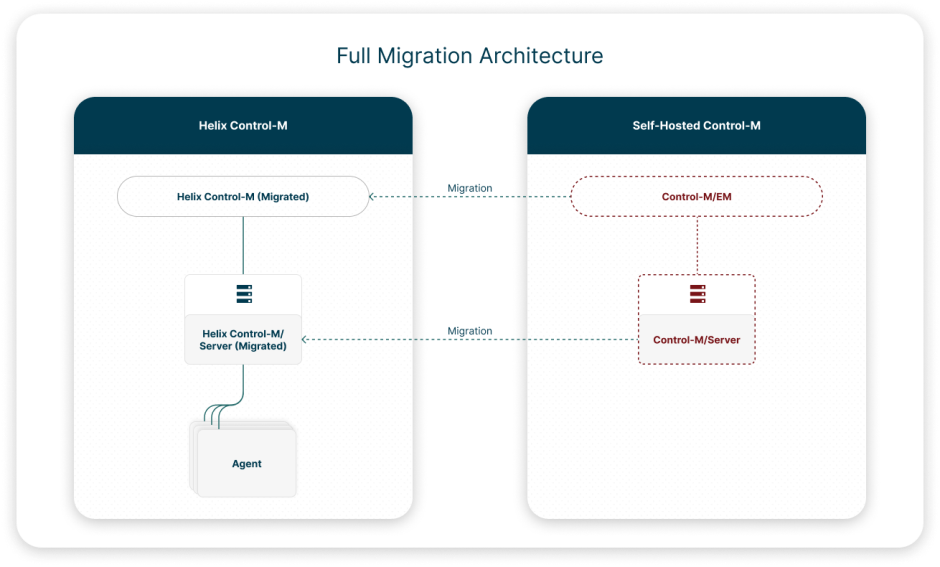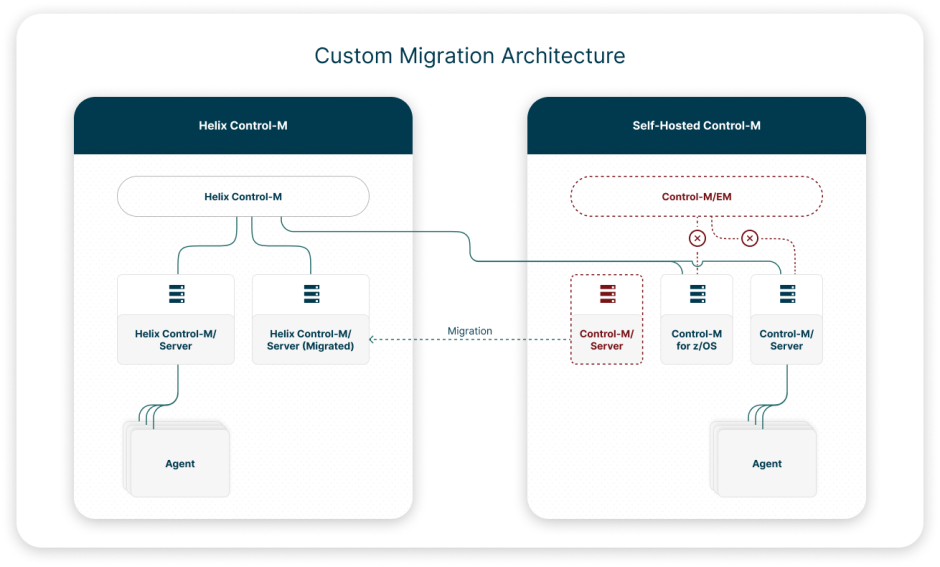Helix Control-M Migration
The Helix Control-M migration process enables you to migrate some or all of your self-hosted Control-M environment to Helix Control-M. Before you migrate, you must run a qualification scan with a BMC presales team, who helps you determine the migration type that best suits your organization. Helix Control-M migrations eliminate the need to maintain Control-M/EM, migrated Control-M/Servers, and their associated databases.
-
If you are unable to upgrade to Control-M/EM 9.0.21.300, you cannot disconnect your self-hosted Control-M/Servers from Control-M/EM and connect them to Helix Control-M. However, you can migrate your Control-M/Servers to Helix Control-M, as described in Helix Control-M Full Migration.
-
You cannot migrate Control-M for z/OS environments to Helix Control-M. However, you can connect them to Helix Control-M Unified View, as described in Helix Control-M Unified View Migration.
-
You cannot migrate Control-M/Servers with Agents on unsupported operating systems or with unsupported plug-ins to Helix Control-M. However, you can connect them to Helix Control-M Unified View, as described in Helix Control-M Unified View Migration.
-
If your Control-M/Servers or Control-M for z/OS environments execute more than 100,000 jobs daily, you must distribute these jobs on two or more Control-M/Servers or Control-M for z/OS environments.
-
You cannot revert a Helix Control-M migration after you have migrated.
The following is a summary of three Helix Control-M migration types:
-
Helix Control-M Full Migration: Migrates your Control-M/EM data and all Control-M/Servers to Helix Control-M. This eliminates the need to install and maintain Control-M/EM, Control-M/Servers, and their associated databases.
This option is dependent on the results of the qualification scans, as described in Helix Control-M Qualification.
The following diagram shows the logical architecture of a typical Full Migration environment:
-
Helix Control-M Unified View Migration: Migrates your Control-M/EM data and connects your self-hosted Control-M/Servers and Control-M for z/OS environments to Helix Control-M. This eliminates the need to maintain your self-hosted Control-M/EM and its database, and enables you to access your self-hosted Control-M/Servers from Helix Control-M Unified View. You can run and manage your self-hosted Control-M/Server and Helix Control-M/Server workflows via the same interface in Helix Control-M Unified View.
This option is dependent on the results of the qualification scans, as described in Helix Control-M Qualification.
The following diagram shows the logical architecture of a typical Helix Control-M Unified View Migration environment:
-
Helix Control-M Custom Migration: Migrates your self-hosted Control-M/EM data to Helix Control-M and enables you to perform an enhanced full migration or a customized migration. A customized migration enables you to determine—based on your organizational needs and the results of the qualification scans—which Control-M/Servers migrate and become Helix Control-M/Servers, and which Control-M/Servers remain self-hosted, but connect to Helix Control-M Unified View.
This migration eliminates the need to maintain Control-M/EM and some or all Control-M/Servers and their associated databases.
The following diagram shows the logical architecture of a typical Custom Migration environment:



 YouTube
YouTube Twitter
Twitter Facebook
Facebook LinkedIn
LinkedIn